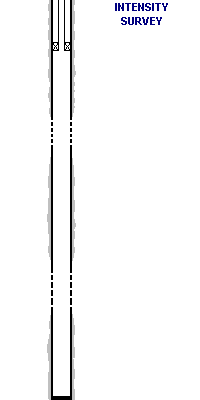

The Intensity Profile is one of two primary survey methods used by Cardinal Surveys for running injection profiles. We eject a slug of radioactive material above the perforated or open hole interval. The slug is monitored by pulling the detector up through the slug as it travels down hole with the chart recorder in depth drive. Travel times are noted at the peak of each run and can be used in a fashion similar to the modified velocity profile run on production logs. Our main intent is to document the loss of radioactive intensity from the slug as it travels down the well. As you loose injected fluid, you will loose radioactive material from the slug.
Intensity Profile VS. Stationary Velocity Profile
Much has been written about - velocity profiles - in various professional publications. Velocities are nearly always favored over the intensity profiles. You normally have a much higher resolution with the velocity profile due to the fact that you can divide the well up in segments equal to the distance between your detector and ejector. In our case that is 5 feet.
The limiting resolution factors for an intensity profile are rate and wireline speed. The resolution of the intensity profile is limited to how often can you run up and down through the radioactive slug as it travels down hole. Keep in mind that there are factors concerning safety, log quality, and mechanical tolerance governing wireline speed. On the "Average Injection Well" we normally catch the peaks of the intensity slug approximately 15 to 30 feet apart. Thus our resolution is 15 to 30 feet for determining fluid losses.
Intensity profiles do have significant advantages over velocity profiles. Slight variations in the well's internal diameter do not have a drastic effect on the calculated results. Also, minor fluctuations in the injection rate does not hamper the calculations of fluid loss due to the fact that it is not based on rates.
Each profile method has advantages and disadvantages over the other. This is why we typically run both survey methods on injection profiles. However, it is our opinion that the intensity profile is the better of the two in field applications.
Injection Profile Page
Cardinal Welcome Page
